|
|
#1 |
|
FFR Simfile Author
|
(If you're looking for a particular term, please use ctrl+f to find it! Also, I use british spelling, i.e. colour instead of color)
Describing rhythms, patterns and charts in shorthand Instead of creating a pattern, taking a screenshot and uploading it, a simple shorthand can be used, such as [15]3[24]3[15].[26]4[35]4[26] . Every character, bracketed group of characters or rest (.) indicates one 'step' at the note interval given (if it is not stated, figure it out by looking at the part of the song/chart being referenced). Valid symbols are as follows: .: A rest. Nothing plays here. x, X, o, O: A note plays here, but the column and/or number of them is not important. Used to represent a rhythm, e.g. x.x.xxx.xxxx.xx. A, B, C, D, etc: The specific columns are not important, but all As are the same column and so on. Used to talk about patterns without specifying exact columns. For instance ABC.CBA is a triplet, a rest, the same triplet in reverse order. 1, 2, 3, 4, etc: A note plays here at the specified column. For instance 1234321.4321234 is a > shape, a rest then a < shape. [12], [24], etc: Notes play here at all the specified columns at the same time, forming a 'chord'. For instance [16][25][34][25][16] forms a wide X shape. [1], [2], etc: A chord with N number of notes, but the columns are not important. For instance [1][2][3][4][5][6] gets bigger and bigger until it fills the screen. To save space, one can say 'Chord sizes 123456' instead. Now that you've read this, try to figure out what the example shorthand at the top creates. Note that the shorthand provides no way of representing things like holds, mines and finer note intervals (e.g. if you wanted to express some 24ths within a 16th pattern you'd have to use the smallest interval that contains both, 48ths). If you need them, either improvise or make a screenshot. The building blocks of charts Tap, note, hit, arrow, step, single: Your basic note type. By itself, scored by depressing the key corresponding to its column as accurately as possible. Chord: Generic term for 2 or more notes sharing the same point in time. Names for chords with specific numbers of notes in them are as follows: 2-chord: Jump, double 3-chord: Hand, triple 4-chord: Quad, quadruple 5-chord: Quint, quintuple 6-chord: Hex, sextuple Chord cohesion, chord cheating: In Stepmania and Thirdstyle, chords are scored only when their last note is hit, and are visually cohesive: they are either all hit or all missed. This mimics the way DDR handles 'jumps' but is contrary to the way almost every other rhythm game works. This has a side effect of making extra taps 'unpenalized' so long as the last note of the chord is hit on time. Imagine a pattern [1234]11[1234]: You can hit [1234] four times in a row, as the extra 234s do not trigger early judgements, and the final 1 completes the chord on time. In FFR/KBO/IIDX/etc. the notes of a chord are judged separately, and so you can hit one early and the others on time and your judgements reflect it and so on. Hitting the notes of a chord separately is called splitting the chord. If you tried the same trick on one of those engines you would receive three boos for hitting the [234] early. Hold, freeze, long note: A note that has a start and an end. The hold is scored both by how accurately you hit the start and by how well you 'hold' it down until the end. Hold cheating: In Stepmania and Thirdstyle, because their holds emulate DDR's, they have a 'fade out' time of 1/4 seconds: If you release a hold but resume holding it OR the hold ends before that timer elapses it is considered to be held again. This makes it easy to cheat patterns with holds in them by, for instance, hitting hold 2, hit 11 as 2[12][12]. In KBO, holds are instantly ended if you lift the key and cannot be resumed. In IIDX/O2Jam the holds are forced release holds and judge you by how accurately you release them. Early release breaks combo. Concerning holds and chord cohesion: In Stepmania and Thirdstyle, the hold part of chords with holds in them is not cohered to the rest of the chord, but the tap part of those holds is. That is, you can miss a chord because you missed some of its notes yet get O.K.s because you held hold(s) in it to the end. Adding holds to a chord does not make those notes separate from the chord. Only moving notes to different times can make those notes separate from the chord. Mine: A note that you are not meant to hit. In fact, if you are holding the key corresponding to its column when it passes the target, it will explode and lower your life and score dramatically. In ITG and in noteskins that do not alter it, looks like a rotating metal circle with a flashing red center, but many alternate graphics exist. Mines are often used, not to make a file harder, but to make it visually more interesting. See Mine Theory. A dense column of mines can be playfully referred to as a mine hold, and if accidentally hit will result in failing fast. Mines on all columns is a mine wall. Mines roughly uniformly injected around notes is called a mine field. Stepmania and ITG are (as far as I know) the only games implementing mines. Offset: A measure of how far into the song the first beat of the chart is. Note that negative values indicate the chart starts later, while positive values indicate the chart starts before the song. To find the offset, either use trial and error at rate 0.3x or open the song up in a program like Audacity or DDream Studio that shows the waveform of the song; the offset of the chart should be the (negative) of the timestamp of the first 'peak'. BPM: Beats per minute, or a measure of how fast the song is. To find the BPM, use Mixmeister BPM Analyzer on the song and round to the nearest whole number. If it reports the wrong number or if the song is made of multiple BPMs, time it using This page and use the nearest 'right sounding' number, and adjusting if you see it go off later. If a song has a speed up, slowdown or 'drifting' BPM, use low rates and trial and error to ensure every beat is on sync. BPM change: A change in the BPM mid chart. Mandatory if the song changes BPM, but it can also be used to create BPM gimmicks where BPM changes are used to change the speed of the chart (and of anything that animates) in a way that either increases difficulty or is expressive and visually pleasing. BPM gimmicks can easily be made by using the stepmania editor's 'expand/compress' tools which are accessed by making a selection by holding shift and moving then accessing the menu under enter. (Please ensure that the chart is valid before saving! There are some bugs.) Stop: A pause in the chart that lasts a certain number of milliseconds. Because it is expressed in milliseconds and not fractions of beats, it will be a tiny amount offsync with most bpms and you will need to make adjustments manually if lots of stops are used so that you do not get drift. They are very rarely used for syncing and mostly used for BPM gimmicks. BPM gimmicks involving stops can easily be made by using the stepmania editor's 'convert beats to pause' tool which is accessed by making a selection by holding shift and moving then accessing the menu under enter. (Please ensure the chart is valid before saving! There are some bugs.) If you need to calculate a stop by hand, perform this calculation: Length of one beat = 60/BPM Length of half a beat = length of one beat /2 Length of one third of a beat = length of one beat /3 et cetera. Most bpms will give you a number that has more decimal places than three; to ensure your chart does not drift, manually edit some of the stops in the .sm so that, on average, they add up to the rest of the number. For instance, if you have many 0.33333... length stops, make every third one 0.334. (Reload from disk after you do this to save your changes.) If you place a stop on a triplet fraction of a beat (such as 0.33333... or 0.66666...) please manually edit the .sm and add 1 to the last digit, i.e. to make it 0.334 or 0.667, then reload from disk. Why? If you do not, on some versions of Stepmania (e.g. 3.9), the stop (which is at 0.333) will be considered to be before the note (which is at 0.33333...). Most people would expect the stop to take effect after the note and so your chart will behave in unexpected ways. Esoteric building blocks of charts Negative BPM/negative stop: Editing the .sm to make a BPM change or stop negative can be exploited to make charts that warp to a later point and skip everything in the middle. It is a black art, as it relies on glitches in the stepmania 3.9 coding. It can be used to create charts that 'move backwards' or change in place, such as in http://www.youtube.com/watch?v=VLVWQuKo_8U Because it is a side effect of how Stepmania 3.9 was programmed, negative BPMs and stops are not supported in any other rhythm game - EXCEPT for Thirdstyle, since it exactly replicates Stepmania 3.9's timing code. Roll: A note type that first appeared in ITG and is rarely seen outside of pad charts. Looks like a spiky hold, except instead of holding it to get an O.K. you must tap it again every 0.3 seconds or more often. Only supported in ITG and Stepmania 3.95/4/sm-ssc. Rolls are often used in modern ITG charts simply for keysounding, especially so when they're too short to actually require a second step to keep active. Lift: A note type that is almost never seen, looks like an X by default. Instead of being scored by the button being pressed, it is scored by the button being lifted. Only supported in Stepmania 4/sm-ssc. An example of lifts: http://www.youtube.com/watch?v=GWwDWN3Sflg#t=0m36s Other note types: Stepmania 4.0 and sm-ssc support many additional note types not available in Stepmania 3.9 or in KBO, such as fake and invisible notes. Terminology for patterns (Note that pad specific patterns are not covered. Look at a pad terminology guide if you're interested!) Pattern: A specific way in which the columns of sequential notes relate to each other. May hold under certain transformations of columns but not others, depending on the pattern (for instance, a zig-zag still looks like a zig zag if mirrored, but if its columns are shuffled it will look more like a running man). A pattern is assumed to run at the same note interval throughout; normally 16ths, but can be qualified with a different interval, i.e. a 24th stream Stream, run: A long run of notes at the same speed. A short stream (e.g. less than 16 notes) can be called a streamlet.  Burst: Any short but particularly fast pattern. Typically used when the pattern is not easy to hit. 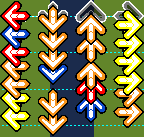 Jumpstream: A stream but with jumps (chords of two notes) in it frequently. Can be 'sparse' or 'dense'. 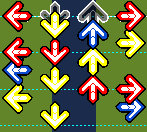 Handstream, chordstream: A stream but with jumps, hands or even bigger chords in it frequently. Can be 'sparse' or 'dense'. 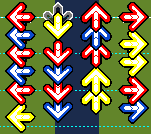 Doublestream: A long run of 2-chords at the same speed. In a solo chart, typically looks like two streams at the same time. Holdstream: A stream with holds in it. Typically hard to hit. 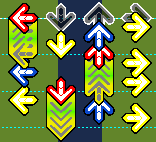 Trill: Alternating between two columns. A minitrill is a short trill, typically five notes or less. Trills can be on their own or part of a stream. 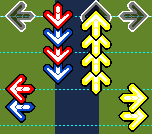 A one-handed trill alternates notes on the same hand, and is noteworthy because it is much harder than a two-handed trill. 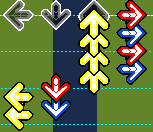 Jumptrill, chordtrill: A trill consisting of 2-chords or larger instead of single notes. Noteworthy in that, despite its higher density, it is typically not any harder, but is more likely to contain one handed trills. 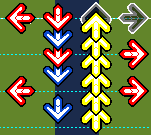 To refer specifically to two simultaneous trills and definitely not a trill with other jumps at the same time, try doubletrill.  Jack: The same column over and over, for example 11111.  Minijacks are short jacks, typically five notes or less. A doubletap is the same column twice in a row. Jacks are noteworthy because of how difficult they are to hit above 8 notes per second; slow jacks are said to be hit by 'wristjacking', but when jacks get too fast (above 10 notes per second) you must 'vibrate' your arms to hit them at the right speed. If a jack is faster than 14-17 NPS it is nigh impossible to combo. Vibrating is a skill not all people have and is hard to train. 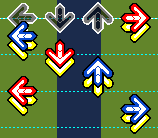 Even if a jack is faster than your highest jacking speed, it can still be comboed by starting early and/or ending late, known as rushing. If a jack goes into or out of a jump (2-chord) it is known as a jumpjack. Similarly, we have handjacks, quadjacks and chordjacks. 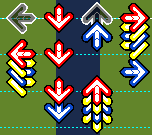 If a jack is nothing but 2-chords one can use doublejack to be more specific. 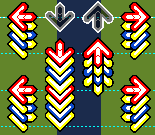 Hidden jack: A stream, jumpstream, etc pattern that creates a jack at half the stream speed. For example, [14]3[12]3[13]4[12] has a 1 jack. Typically the more hidden jacks are in a jumpstream pattern and the longer they get the harder it is, and paying attention to where they are will help you hit it at the right speed. See also running man 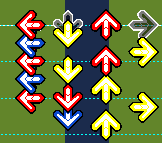 Doublets: Groups of two successive notes with gaps between them. 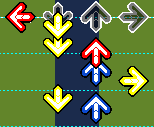 Triplets: Either used to refer to the note interval 12ths, or to groups of three notes with gaps between them (e.g. 124.421.124.421), or even rarer to a repeating pattern of three columns with no gaps (like 124124124) 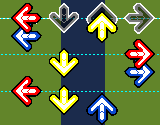 Pentuplets: Groups of five successive notes with gaps between them. 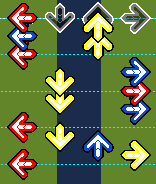 Step jumps/stepjumps: Alternating jumps (two note chords) and steps (single notes), usually at 8th speed (called jumpstream instead if faster). 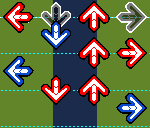 Chained jumps: Step jumps where the steps between the jumps tend to share columns with the jumps. Usually harder than equivalent stepjumps. Can also have chained trills, chained chords, etc 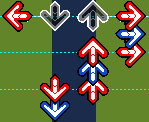 Zig zag: A stream that moves to adjacent columns with each new note, for example 123212343234. A broken zig zag sometimes makes bigger leaps but usually moves to adjacent columns.  Running man: A pattern that alternates a fixed column and a wandering column, for example 123242321242. (A stream pattern with a hidden jack in it) Notable because it can be as hard as a one handed trill if it features many one-handed patterns, but if it does not it is a very easy stream pattern. Also referred to as anchor, anchored patterns since one column is considered 'anchored' while other notes wander. Trills that tend to share a column can be called anchored trills. 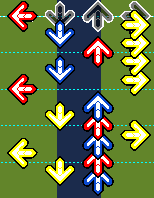 Roll: A pattern that repeats a sequence of four notes over and over, for example 1234123412341234. Rolls can also exist for sequences of three, five and six notes.  Staircase, ladder: A pattern that keeps moving one column in the same direction, for example 123456. A spiral staircase bounces back and forth, while a repeated staircase repeats the staircase over and over, and a shifting staircase keeps doing staircases in the same direction but with different columns, for example 432431421321 is a shifting staircase of period 3. 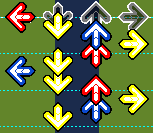 (spiral staircase) 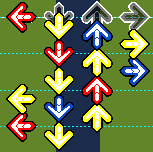 (shifting staircase) Spin: Named after the way it makes you move in DDR, it is a pattern that looks like 12431243 or 21342134. It is a type of roll.  Panning: Any pattern that produces a feel of going from left to right or right to left, either in repeating bursts or in a long continual pattern. Can be used for pitch relevance. Examples of non-trivial pans: 1232413234, 12132434, 12314234 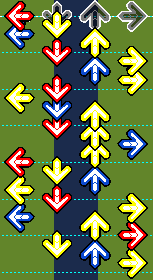 Sandwich: A pattern like [13]2[13] or [14]2[14].  A half sandwich omits one of the notes from one of the jumps.  Dive: A pattern like 12[34] or 23[14] where you hit all the columns in a row, ending in a jump. So called because of the motion your fingers make playing it index.  Tell jumps: A pattern like 12[12] or 14[14] where you hit a step, a step then the jump consisting of both steps. Named after a chart in In The Groove, Tell, where you had to do this difficult pattern many times on pad. 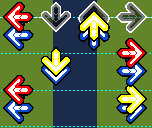 Reverse tell jumps do the jump, then the steps. Bracketing: A pattern that only exists in solo (6-key) mode, it looks like [13]2[13]2[13] or [46]5[46]5[46]. Notable because it is considered the hardest one-handed pattern to do in solo. The more bracketing a chart makes you do, the harder it is, so use it when appropriate. If one or more notes are missing from the jump parts of a bracket, it's a broken bracket. A bracket that lasts for only two notes (e.g. [13]2 or 2[13]) is a half bracket. Ringtrill: A pattern that only exists in solo (6-key) mode, it looks like 1212121 or 6565656. Notable because it is a difficult one-handed pattern and a precursor to bracketing. Swing: An aspect of the music where every second note is slightly late, forming a X.XX.XX.XX looking pattern. Types of swing include 24th swing, 12th swing and 64th swing depending on what note interval they use. Other intervals for swing are rare but possible.  Gallop: A pair of notes even faster than swing, typically 16ths or faster, e.g. X..XX..XX..XX 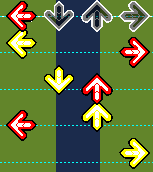 Flam: A pair of notes even faster than gallops, so fast that they seem to be hit in the 'same motion', typically 32nds or faster.  Slide: Three or notes arranged very close together, typically 32nds or faster, typically in a staircase pattern.  Reversing pattern: Doing a specific pattern, and then doing it backwards. Useful e.g. to represent a melody that goes down then up. 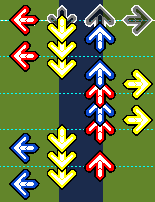 Mirroring pattern: Doing a specific pattern, and then doing its mirror (mirroring swaps the chart horizontally). Useful e.g. to represent a melody that repeats but at the same time doing something new each time. 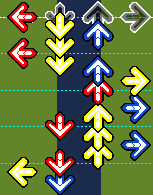 Shuffling pattern: Doing a specific pattern, and then doing its shuffle (shuffle is any rearrangement of the columns). Useful e.g. if a specific melody or fill occurs very often and identical patterns would get boring fast. In addition, if the key of the song changes you might shuffle all patterns to reflect this. 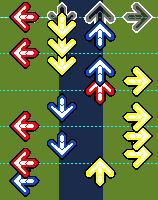 General terminology TS, Third Style, Thirdstyle: You're on it! An offshoot of FFR intending to fix many of the fundamental flaws of the system. It has a modern engine, holds, multiple difficulties per song and aims to focus on the music side. FFR, Flash Flash Revolution: 4k. Ancient, well over a decade old. Started by Synthlight and hacked together into a monolith over the ages. Has various quirks, such as frame-based quantization of notes, score-decreasing boos when you hit empty space, a slightly early perfect window but also has a HUGE selection of songs - well into the thousands now. KBO, Keybeatonline, Keybeat Online: A 4k/6k flash rhythm game run by Stargroup and coded by Blast. Nice engine. No longer exists RIP DDR, Dance Dance Revolution: A 4-panel rhythm game put out by Konami that would later inspire FFR, be emulated by Stepmania and kick off everything else. Instead of playing with a keyboard, you play with your feet on a dance mat 83cm*83cm. ITG, In The Groove: A spinoff of DDR by Kyle Ward, with a mostly lackluster selection of music but aimed to provide a highly varied and more difficult set of charts ranging from 9 to 13 feet for experts, involving complicated rhythms, hold usages and new notetypes like mines and rolls never seen in DDR. Notable because a later build of ITG2 lets you play custom files, and so the amount of diversity possible on an arcade game is incredible, especially when the machine is 'hacked' to put custom made files on it, so everyone can play them there without difficulty. O2Jam: A 7k keyboard rhythm game, notable for things like forced release holds and its rather artistic chord/hold spam/smash patterns involved at higher levels that make everything look like a blur. IIDX, Beatmania: Another rhythm game by Konami. Started out 5k + one turntable that you 'scratch' to hit notes in a sixth column, eventually became 7k + one turntable. The buttons are arranged like a septulet of piano keys, white and black. The notes in IIDX are literally keysounded - when you hit a note, it plays a sound that was attached to the note, and thus create the main parts of the song by how accurately you play. FTB, Feelthebeats, Feel The Beats: A 7k flash game with wholy user generated charts. Played using the key setup asd[spacebar]jkl. Has taps, holds, no chord-cohesion, bpm gimmicks and a negative bpm system which is NOT like Stepmania 3.9's - it actually scrolls the chart backwards! Osu: An emulator for Ouendan/Elite Beat Agents, akin to how Stepmania is a DDR emulator. Targets appear on screen that you have to click (or touch, using a tablet/touch screen) when rings around them reach their outsides. Notable in its success is the things it does that Stepmania does not - online integration from within the program means that you can chat with everyone else playing osu and even watch them play. You can download and upload beatmaps (their name for files/charts) straight to the central database on the site, where they have highscore tables kept and are reviewed by official quality control teams to ensure that every file that makes it there is worth playing. Stepmania 3.9: The build of Stepmania most people use, because Stepmania 4.0 is still in alpha or beta or whatever. It also has a very stable editor. Download here: http://www.stepmania.com/wiki/Downloads Stepmania 3.95: Acts like 3.9 but has support for stepmania online like sm 4.0/sm-ssc, plus probably other things. Download here: http://www.staiain.net/StepMania/Pro...6-19-2005_.rar Stepmania 4.0: The latest build of Stepmania, slowly but surely being updated. Still in alpha or beta or whatever. Download here: http://www.stepmania.com/wiki/Downloads sm-ssc: A fork of Stepmania 4.0. Supports KB7, LUA integration into themes/mods. Download here: http://www.keybeatonline.com/forums/...ead.php?t=2096 Stepmania Online, SMO: Accessible using Stepmania 3.95 or higher, allows multiple people to play the same song at once and to record how well everyone is doing. Currently located at http://stepmaniaonline.net DDReam Studio: A standalone editor for stepmania charts that, among other things, shows the waveform under the chart and syncs by visually pleasing beats instead of by using bpm changes. An efficient tool for songs that 'drift' because they were recorded live, as well as for various other tasks. Download here: http://www.ddreamstudio.com/ Notes per second, NPS: A measure of how fast a pattern is. To convert a bpm plus a note interval to NPS, do this: Beats per second = BPM/60 Notes per second = beats per second * notes notes per beat (e.g. 4 for 16ths) To convert an NPS to a BPM given a note interval, do this: Beats per second = notes per second / notes per beat BPM = Beats per second * 60 Notes per measure, NPM: An easier metric to calculate when you're comparing within a song or comparing two songs of the same BPM. e.g. 'This part is way too hard for a beginner chart, it's 4 NPM while everywhere else it's only 1 NPM.' Stepping, charting: The process of creating a file/chart/stepchart for use in Stepmania or whatever other rhythm game you're making it for. Playtesting: The thing you should do after you've made your chart. If you forget to playtest you'll release charts like this: http://www.youtube.com/watch?v=G56Y8BT_6jM Measure: Four beats long. Always four beats. Note interval: The speed at which notes come relative to measures. 4ths means four notes per measure (beats), 8ths means eight notes per measure (beats + half beats) and so on. Divide by four for the number of notes per beat. Note colour: Notes are coloured according to the first note interval they fall into, going from the slowest to the fastest. Red for 4ths, blue for 8ths, yellow for 16ths, orange for 32nds, green for 64ths, and at the same time purple for 12ths, pink for 24ths, cyan for 48ths. 96ths and 192nds are green, gray or silver depending on the specific noteskin and version (Silver in Thirdstyle). Certain stepmania noteskins use different colours: Green instead of purple is a common change, as is changing cyan and green. Steady 4ths: red, red... Steady 8ths: red, blue, red... Steady 12ths: red, purple, purple, red... Steady 16ths: red, yellow, blue, yellow, red... Steady 24ths: red, pink, purple, blue, purple, pink, red... Steady 32nds: red, orange, yellow, orange, blue, orange, yellow, orange, red... Steady 48ths: red, cyan, pink, yellow, purple, cyan, blue, cyan, purple, yellow, pink, cyan, red... (note how cyan, yellow, cyan is being interwoven) Steady 64ths: interweave greens into 32nds Steady 96ths: interweave silver, orange, silver... into 48ths Steady 192nds: interweave silver, green, silver...into 96ths Song choice: The art of picking a song that is nice to listen to and makes for interesting, varied and not too inconsistently dense steps. Bad song choice violates one or more of these. Pitch relevance: Choosing patterns and columns specifically to reflect the ascension, descension, repeating and variance of melodies and notes therein. For instance, a melody that goes low, low, mid, high, low might be represented as 11231. Because there are less columns than possible pitches, making a good representation of a melody is a bit of an art. Sometimes, the relative positions of notes are more important than the ascending/descending feel, e.g. if a melody goes low, low, med, low, low, high having the lows on the same columns tends to be more important than having the med to the left of the high. When the key of a melody changes, one can represent this by shuffling the pattern used for that melody. Related to pitch relevance is placing 'bassier' instruments toward the left while others go towards the right. An example is many old Kil files like History of the Moon where snare jumps are almost always [34]. Percussive relevance: Choosing columns specifically for different instruments. Should be rotated every X measures, or you'll end up with c1 bass syndrome. Hand relevance: One hand plays one of the instruments, while the other plays the other (or a percussive track(s) or whatever). Creates interesting patterns in solo mode. Keysounding: 1) Using a specific note type when a specific sound plays in the music (tap, jump, hold, mine, etc). The 'keysounding catalogue' might change when instruments drop in and out or during different sections of the music. You might keysound the same portion of the music the same way or different ways depending on whether you want the chart to feel cohesive or whether you want to try something new. 2) Chopping the music up and tieing each sound to a note, such that hitting the note plays the sound, and hitting it inaccurately makes the sound play earlier or later. Implemented in sm 4.0 and sm-ssc, but requires a 'master track' for the song that is split up into its instruments or composite sounds already. Appears in some rhythm games (IIDX, DJMAX Trilogy) and not others (DDR, Guitar Hero) Layering: Laying down notes for one instrument, then laying down notes for another instrument, etc for 2 or more instruments. Sometimes the first instrument (usually a melody)'s patterns are not changes to compenate for the other instruments, but if this is too awkward or does not allow the other instruments to be altered enough, the gestalt pattern will be shifted around to place the new notes more neatly. The 'layering catalogue' might change when instruments drop in and out or during different sections of the music. You might layer the same portion of the music the same way or different ways depending on whether you want the chart to feel cohesive or whether you want to try something new. Semi-Layering: A technique where two layers are compressed into one. That is, pick two instruments A and B. If A OR B plays, place one note. If any column relevant techniques are being used, the arrangement could be based on A, B or a gestalt of the two. The technique is used to bring out background instruments without adding strong-implying larger chords, as well as to add in novel rhythms an instrument is playing without having to grow chords to accomodate, say, its constant 8ths. Semi-Layering can be combined with keysounding, as in the following: If A OR B plays, place one note. If A plays, the note is a hold. Compliment, complimentary: An instrument that tends to play on the same times/with similarly timed patterns as the first. Prominent, prominence: An instrument is prominent if it's one of the first things you focus on when listening to the song. An instrument is secondary if it's not prominent but loud and distinguished enough such that if it appears as a layer in a chart you can tell what it went to immediately. An instrument is inaudible if it is technically there but so quiet and unnotable that you'd never pay attention to it unless you listened to the song dozens of times or if you noticed a charter's layering was bizzare and tried to figure out what inaudible instrument was being included. Typically a chart should focus on prominent instruments, but when a secondary instrument compliments something primary it is good to acknowledge it as well. Following of non-complimentary secondary instruments and inaudible instruments tends to lower expressiveness but can make the file more interesting/challenging. Technicality: How well you chart follows mechanical rules of pitch relevance, keysounding and layering. Sometimes strict technicality results in awkward patterns, uneven difficulty, etc. Can be referred to as the 'objective' aspects of a chart. Expressiveness: How much a chart evokes the feel and idea of a music. Can be thought of in terms of information theory: the more of a chart is chosen randomly with respect to music ('noise'), the less expressive it is. Things that can be chosen deliberately are not restricted to rhythms, it can be specific layering choices, specific patterns and column usages, deliberately repeating and not repeating sections and so on. In addition, sufficiently complicated songs with lots of background instruments are not typically processed by the human brain in terms of individual layers, but in the overall feel - in such cases, songs can be made more expressive not by picking out 2-3 instruments and layering them but by altering how many notes are present according to the gestalt -feel- of the song. (A corollary of this is that chiptune songs are much easier to make expressive.) Can be referred to as the 'subjective' aspects of a chart. Prettiness: The use of patterns based on how they look visually, typically involving things like symmetry and staircases. Much easier to do in solo than in singles. Commonly employed in O2Jam charts and occasionally in bms (IIDX emulator) charts. Fun: Did the chart make you want to play it again? A fun file usually consists of a song worth listening to, patterns that compliment the song well and patterns that flow well in their own right - all of these factors are important. Note that some files are replayed not because they're intrinsically fun but because they offer a challenge no other file does. Generic: Referring to patterns that appear in most songs/charts, for instance alternating 8th jumps and steps. Sometimes the most appropriate way to step that part of the song, sometimes a waste because there is something more interesting and unique to the song that could be followed instead. In general, patterns are less generic on solo than on singles; even if the rhythm and chord sizes are generic, you can use column-specific techniques to express something that is unique to the chart, while in singles it is likely that attempts will not have enough room to express what you want and so will either turn into noise by having to vary too much or become boring by repeating the simplistic pattern too rapidly. Subjectivemanias: A meme born from the observation that different people look for different things in an ideal chart; a chart that is well made can be found enjoyable by one person and lackluster by another. BPM Gimmicks: Using bpm changes and stops not to sync but to make an impressive visual effect and/or to increase difficulty when played on an x-mod. A chart designed around its use of BPM gimmicks is called an X-mod chart. Here is an example of an x-mod chart: http://www.youtube.com/watch?v=hVcjR52DaZQ X-mod charts can be ranked by how much memorization they require. BPM Gimmicks that 'balance' out every stop and bpm change locally so that no note actually changes position require the least memorization, while charts that move notes from their 'true' location require the most. Particularly of note are prolonged double speed portions that will require lots of memorization if a speed is used to make the rest of the song comfortable to read. Common types of BPM Gimmicks: Speedup/speed-up/speed up: The BPM doubles or is raised for a section of the file. Slowdown/slow-down/slow down: The BPM halves or is decreased for a section of the file. Stop: Sections of the chart are turned into stops, so you have to know the rhythm in advance. Stutter: Notes are left as they are, but between each note a stop is placed for half the duration and then the bpm doubled, such that the chart stops after each note then jerks towards the next. Continual speedup, continual slowdown, boost, brake: For a visual effect, the bpm is slowly raised or slowly lowered to a target bpm. Stop-short: Speeds towards the next note only to stop just before it, keeping you in suspense and wanting to hit it/making sure you've memorized when it's meant to come. Wobble: An alternating pattern of speedups and slowdowns, e.g. http://www.youtube.com/watch?v=zPT4Xr0raLA and http://www.youtube.com/watch?v=M7lX_BxG4fE . Sometimes a wobble occurs alone - it can either be a dip of low speed between notes then a racing towards the next one, or a high speed portion that is balanced by a slowdown just before the next note comes. Negative BPM/Negative stop/warp: The chart suddenly jumps forward, skipping over a lot of notes that you thought you'd have to hit, or over empty space/while holding a hold in games that don't allow you to skip over notes. Can also be used to pull up another part of the chart that -looks- like what you were at before, but with a change (notes and mines swapped, moved closer/further away, something removed/added, etc) FTB style negative bpm: The chart scrolls backwards! Only works in Feel the beats, or by meticulous use of negative bpms to skip forward to replications of the part of the chart only slightly further away each time - akin to drawing many frames on a flipbook and flipping through them. Modded course, marathon: Stepmania allows you to set mods to appear and disappear at any speed, with any % strength (even negative in stepmania 4.0 onward), at any point in a course; by syncing combinations and transitions of mods to aspects of the music, a modded course is formed. A difficult artform to master as there is no specialized editor or program for modded courses (yet?). Example of a modded course: http://www.youtube.com/watch?v=hIkRx6rLaZM WinDEU has started making a tutorial for modded courses: http://www.youtube.com/watch?v=tb0k4k49tC8 C1 bass syndrome: A chart that uses the same column (usually 1, hence the name) for every single bass kick it layers. Occurs in many IIDX and solo charts. Noteworthy because of how routine and mundane it looks: many many songs have a bass kick every 4th note, and so it is not particularly expressive to show this. On the other hand, if the song has very fast bass rushes, putting them all on the same column can make it quite awkward, especially if they get too used to the monotony of pressing 1 every 4th note. Bias, Left-handed Bias/Right-handed Bias: A pattern or a chart that is more demanding on one hand than on the other, either deliberately or accidentally. Left-handed bias seems to be more common (likely because of similar reasons to C1 bass syndrome), while most players' dominant hand is their right, leading to mirror being a common mod used. Flow: How slick a chart feels on the fingers, how smooth it is to play. Flow-interrupting aspects are those that seem unintuitive and jump out at you to mess up your run. Things like: Notes right after hold ends, fast left/right biased patterns, bursts with awkward patterns, anything that forces you to mash. Theory: Any one of a number of techniques that don't rely on a strict technical perspective in charting, and modify the way the chart is made according to other aspects of the sounds or the musical feel, or sometimes just to introduce patterns that look/feel good. Climax theory: Deliberately making the chart harder (e.g. by layering more and less or by creating patterns that are more or less abrasive) when the song gets more intense and climactic and easier when it is less intense and climactic. Jack theory: Deliberately creating harder patterns by arranging them to include minijacks, even though there is no musical reason to do so. Can be used to be more expressive or to be more challenging. Mine theory: Using mines not to choreograph places where the player should lift their hands, but rather to express aspects of the music. For instance, mines could be used when the song gets tenser or abruptly has a gap. Alternatively, mines can be used to 'layer' an instrument in a purely visual sense. A 'legitimate' use of mines is to emphasize staccato (abruptly ending) notes, forcing the user to pull off them quickly. Mine art: Creating letters, numbers, symbols and patterns using mines. Can be done during pauses, or even mixed into sparse patterns. Example of mine art: http://www.youtube.com/watch?v=yTPsCdiLOPs Example of mines spelling out things: http://www.youtube.com/watch?v=q63XT6VcnCU#t=2m15s Width theory: Assigning different widths to different intensities/keysounds that cause jumps. For instance [12] [23] [34] (width 2) when it's bass, [13] [24] (width 3) when it's snare, [14] (width 4) when it's crash. Another interpretation is width 2 for harmonious chords, width 3-4 for unsettling chords. A third interpretation is width 2 for bassier pitches, width 3-4 for higher, more standing out pitches (works well when the former are more frequent than the latter). Pop'n Music does this a lot. Essentially an alternative to the 'go left to descend, go right to ascend' or 'bass on left, snare/crash on right' standard formulation of pitch relevance. Guitar wail technique: People like Stargroup and kil have noticed that an effective way to step a guitar wail is with two freezes on separate hands, the second delayed by a 64th. In addition, guitar roar, slide, wobbling etc sounds feel right when stepped with any arbitrary rhythm, as long as it produces the appropriate feel of fastness. See For Seasons (Air Guitar Mix) In Mystery Pack Iamme syndrome: Having one portion of the chart incongruously much harder than the rest, for instance suddenly having a 32nd burst with jumps in it or a 24th jack. Sometimes, this results in top players playing the file only because of that very hard portion. Glove syndrome: Having very very strict layering and keysounding, e.g. never changing the layering within a portion of the music to fill in gaps when another instrument is playing less, always using pitch relevance, always using the same pattern when the same part of the music plays... Almost all IIDX charts are structured along these lines. Baq12 syndrome: Having 'seemingly random' 192nd notes in your music that go to very slight deviations from exact quantization because the guitar player was a tiny bit early or whatever. If the gap is so small as to be imperceptible on rate 1.0x when one is playing the chart, this makes the chart LESS expressive by introducing noise. However, significant and obvious deviations (typically a 64th or greater) add expressiveness if they are common enough so as to be a 'theme' of the music. In addition, it is okay to have 192nd accuracy for solos that are very obviously not quantized. Roar syndrome: Layering so many instruments, especially in 4key, that the chart is filled with hands that don't feel like they should be strong enough for hands. After a certain point, adding more instruments does not make the chart more expressive, as it is too difficult (or impossible) to figure out during play what everything once went to. Thus, only challenge is added. Minifreeze, minihold: A hold so short that you could never let go of it in time. Used to make a note appear visually different, e.g. for keysounding. Note that in some versions of Stepmania (currently only Stepmania 4.0) there is a bug related to minifreezes; if the end of the minifreeze reaches the target before the start is hit, it will instantly become a N.G., meaning that charts full of minifreezes must either be hit early or your score suffers. Staccato note, staccato hold: Some sounds end very fast and abruptly. To indicate this, you can use one or both of 1) making them a minifreeze and 2) putting a mine immediately after the note. Don't place it too close or it will ruin flow. Ossa syndrome: The use of distinct minifreeze lengths for different instruments, such that the chart is more minifreezes than normal notes (or close to it). At some point, adding more minifreezes doesn't aid in understanding. Staggered holds: A chord of holds that end at different lengths. Can be used to represent a sustained noise that ends in a pitch bend, fast piano roll, or is simply composed of different instruments at different times. Sometimes used arbitrarily to make an interesting effect. Overlapping holds: Holds at consecutive times that do not end when the next one begins. Very rarely will a song actually have notes that last past the start of the next note, so often this is used for visual effect or for challenge. Dramatic holds, growing holds: As a sound increases/decreases/changes in loudness/intensity, give it a hold that is longer or shorter to show this. Can be used for echos and 'reverse echos', fade ins and fade outs, for instance. Can also be used for e.g. a hi hat or piano that is made steadily more and more open so the successive hits seem to get louder and louder due to overlap. For extra effect, the holds can become overlapping holds that fill the entire playing field with their growing length! 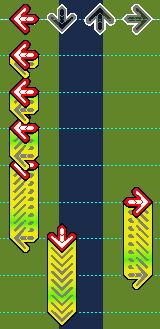 Inverse, inversion chart: A shortening of 'Inversion of Matter and Space'. Indicates a chart where every note is made a hold that extends as far as it possibly can (or leaving a gap i.e. a 16th gap), such that the file is full of holds instead of full of space. Based off o2jam charts that do a similar thing. Legend has it that leonid has a program to make these automatically. As an example, the light difficulty on this file is an inversion of Eggman's infamous Quasar chart: http://sims.anthroaquatic.com/Patash...d%20Quasar.zip Related to inverse is switch where every mine is made a tap and every tap is made a mine. Example: http://www.youtube.com/watch?v=bzVZ9rnHREs Quantized, quantization: Notes that correspond exactly to one of the note intervals Stepmania provides (or occasionally to ones it doesn't, like 18ths). Colour notes, rainbow notes: Notes that do not fall into one of the common quantized patterns, and so are coloured many different colours. Can either be unquantized or simply an uncommon quantized interval, like every third 64th or 18ths (which cannot be represented exactly in stepmania, but can be very very closely approximated) Colour note theory: 1) Using coloured notes deliberately as a form of keysounding, e.g. offset by a 192nd to create green notes. Coupled with bpm changes to bring them back onto the right time, any colour can be used. 2) Making every different instrument a different colour, then using DDReam Studio and arranging beats such that all the notes are so close together that they look like they're on the same spot, and on the correct spots. Seen rarely because of the difficulty in implementing. From 1:20 on this file implements ACA by making the flute cyan/purple/pink colours: http://www.youtube.com/watch?v=xVTnTjtas9Q 3) Making notes deliberately the wrong colour to make it more exciting/stimulating, as random colour notes are associated with unquantized intervals. Alternatively, hides the true note interval being used. Can be seen in many old Kil files. Colour note hiding: Using bpm changes so that a pattern that is unquantized is given the colours of a nearby quantized pattern. Polyrhythm: Layering two note intervals that aren't trivial multiples of each other, such as 24ths and 16ths. Can also refer to an unquantized note interval being layered over a quantized note interval(s). 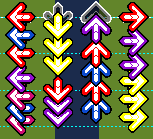 Syncopation: Unexpected, unusual or offbeat rhythms laying on top of the stepchart (empathized through keysounding e.g. jumps/freezes or just by being layered in) e.g. a string of yellow jumps in a row, swung or 12th parts in an otherwise swung song (or vice versa)... Solo, colour note solo, instrumental: A portion of the song characterized by being unquantized and typically much faster/harder than the rest of the song. Drum fill: A one-off pattern of drum hits that usually appears at the end of every block of 2^k measures and differs from the rest of what the percussion plays. When one of these comes up it is usually expressive to drop whatever else you were doing and layer it. Oldschool: A file that is simple, like how files were made for stepmania several years ago. Won't use most of the theories/techniques listed above, likely sticks to simple rhythms, patterns and quantizations, doesn't use too many holds/mines, isn't very technical, etc. This is not necessarily a bad thing; think 'keep it simple, stupid' QED theory, QED file: Named after Q.E.D.'s keyboard files. They are stepped as a compliment to the music with techniques like -consistent flow and difficulty, emphasizing feel over strict musicality -ghost notes to make rhythms fall into expected, easy to follow patterns -syncopating lyrics with 16ths joining groups, as well as 16ths for climactic areas Well known because the community got into a massive hate-on against him back when we were all on FFR, because he stepped things differently and has a huge audience because of all the anime he steps 'in spite of how bad his files are'. Judge for yourself whether you like QED files or not: http://www.youtube.com/watch?v=C8A2vddz_z0 http://www.youtube.com/watch?v=kVpvkLeSvFg Ghost notes, invisible notes: Notes that do not go to any sound in the music. Can either be a mistake or a deliberate technique. Misrhythm: Stepping a rhythm with the wrong number of taps, positions or note interval. Can be done creatively in the case of leaving out less audiable sounds or ones that don't overlap with other instruments or can be a mistake. More likely to occur with instruments that are difficult to make out on lower rates, for instance a series of piano notes that blend together. BS/Bullshit: Any pattern that doesn't strictly follow what's going on in the underlying music. Can either be used to refer to outright fabrications (32nds to vocals) or exaggerations (a rolling pattern when a pitch is descending) Good bullshit files have some aspects that are technical and other aspects that are exaggerated, to make it clear you know what you're doing. Some examples of structured bullshit files: http://www.youtube.com/watch?v=rpqWgVjQ_F8 http://www.youtube.com/watch?v=UiiSmf4hVvs Dump: Used, vaguely, to refer to one of many concepts. 1) A file that is stepped for challenge primarily, expressiveness secondarily. May exaggerate aspects of the song and instruments, 'keysound' things like vocalsbeing said to fast streams and so on. 2) A file that is made overly hard through excessive following of technicality to create fast jacks, difficult polyrhythms or immense amounts of layering. Might be so dense that it is not expressive anymore, might be expressive and very hard. 3) A file that has iamme syndrome or is otherwise uneven/unbalanced. It may also have a particular gimmick that the song was stepped for, and is not interesting enough otherwise. 4) A file that the person does not like for whatever reason. Or maybe it's just plain bad, who knows? 5) Add your own definition because it pretty much means whatever you want it to Gameplay terminology Singles: The 'standard' playing mode for stepmania. 4 columns. Played using the index and middle fingers. Solo: 6 columns. Played using the index, middle and ring fingers. KB7: 7 columns. Played like O2JAM; i.e., like solo but with one or both thumbs hitting the spacebar for the center key. Available only in sm-ssc. Doubles: 8 columns. Because of ghosting and a lack of easy finger setups it is not used as a keyboard style very commonly Couples: 8 columns, but meant for two players - four columns to each side. Not seen much, but great fun in ITG if you have a friend. Spread: The way people here play stepmania. That is, one finger per button per column, going from most dominant (index) to least dominant (rings, pinkies) fingers as more columns are added. Also thumbs for KB7. Contrast to index and one handed. Typical keybindings for spread are, going from first column to last column: qwop, askl, zxnm, qw[], as;', zx./, 1290, 12-=, qw (numpad7) (numpad8), qw (delete) (end), etc Concave setup, convex setup: Because some fingers are longer than others and you typically place your hands on a keyboard angled inward, not straight ahead, it is considered more ergonomic when playing spread to use a key setup like efko or wdlp where the hands are allowed oo maintain their inward angle. This is called concave. On the other hand, someone playing pettanko might want to use a convex setup instead, as rings are much longer than pinkies. Index: Using only your index fingers (or only your middle fingers) to play. One handed: Using only one hand to play. Can use three fingers, four fingers or four fingered 'spread' when the layout is something like left down right 0/ins instead of left down up right and all fingers can be placed in a row. Judgement, judgement window, timing window: The specific categories a note falls into, depending on when you hit it relative to its true position. Traditionally Stepmania is played on a judge setting of 4, making the note intervals the following: Marvelous: +/- 22.5 ms (milliseconds) Perfect: +/- 45 ms Great: +/- 90 ms Good: +/- 135 ms Boo: +/- 180 ms Miss: Greater than 180 ms The size of the windows changes when you change the judge setting. See http://www.keybeatonline.com/forums/...ead.php?t=1866 Justice: The most difficult judge setting. Compared to judge 4, all judgement windows are 0.2x the width. Full comboing on justice is more difficult than AAAAing on judge 4. Targets, receptors, receptacles: The arrow (or circle or bar depending on noteskin) outlines at the top (or bottom if you use reverse) of the screen. When a tap lines up with its target, hitting the button will be perfectly accurate. FC, full combo: Never got a combo breaker (good, boo or miss). FPC, full perfect combo, AAA, triple A: Never got anything worse than a perfect. FMC, full marvelous combo, AAAA, quad: Never got anything worse than a marvelous. Ridiculous timing: An option available in certain versions of stepmania that introduces a new timing window half the width of marvelous. When someone plays on judge 7, all timing windows are half as small, meaning a J7 marvelous is as tight as a J4 ridiculous. A score of all ridiculouses is called an AAAAA. Blackflag: It would have been an AAA but you got one great. Whiteflag: It would have been an AAAA but you got one perfect. XFlag: Missflag, booflag, et cetera. What score you just missed out on should be obvious by looking at the screenshot. Omniflag: 1 of everything, e.g. 1 great, good, boo, miss and possibly even more things depending on the game. Lagflag: It would have been an (FC/AAA) but the game lagged. MA, marvelous attack: Aiming for marvelouses instead of perfects. The higher the count the better the MA. PA, perfect attack: Aiming for perfects instead of great. The higher the count the better the PA. Great attack, good attack: Aiming for greats alone and goods alone. Can be used to achieve incredibly low score passes, like 6.49% on Mythology Expert: http://www.youtube.com/watch?v=PYOzlQLhb1U Rushing, goodrushing, boorushing, CBrushing: 1) Hitting a pattern on time, but because you're one tap short/in excess in one or more of the columns, you are hitting the notes earlier/later in that column and getting combo breakers. Often happens on trills and jacks coming out of difficult transistions and in stream that is too fast for the player to read. 2) Deliberately hitting a pattern starting early and/or ending late, because it's too fast for you to do at the 'intended' speed. you're bs: An allegation that the player is widening his windows/using double setup/using a bot/completely faking scores. Usually not true (unless it's really obvious, e.g. person comes out from nowhere with scores that make no sense and no stepfile choice/knowledge you'd expect from a long time player) and can be countered by an 'im not bs' video that shows the hash of the executible and stepmania being booted up, the lines in stepmania.ini showing the sizes of the judgment windows, a clock and fingertaps during play and that the judge/life settings within stepmania are 4/4. BSing/Bullshitting: 1) Comboing a pattern in an 'unintended' way, such as hitting a 32nd roll as a 16th jumptrill, or hitting extra notes during a chord-filled jack or trill that won't produce boos because of chord cohesion. 2) Being unable to read a portion of the chart and just hitting what it looks like. Mashing: Not being able to read the chart at all and just hitting notes at what you think is the right density. Controlled mashing is when you have a feel for the density/changes in density and are hitting all the keys at as close to the right overall speed as you can. For instance, if a stream is very fast yet very even, a jumptrill is a very good approximation. Double setup: Having two keys bound to each column, and when a very fast jack or trill comes up using some configuration that alternates keys for that column, allowing it to be hit twice as slow as intended. Considered cheating if not explicitly stated as part of the playing style. Sightread: The first time you've played a chart. Called as such because of the related practice of sightreading a piece of music. On some charts your sightread will be your best run, because on successive runs you will start to form mental blocks or get fed up with the song. On other charts your sightread will be your worst run, because of hard parts that require some conscious study to learn or because of building understanding of the song. Mental blocks, bad habits: When you play a chart often enough, your brain picks up on certain parts of it and remembers how they were done in an attempt to simplify later repeats of the activity. This is useful when the portion of the chart is difficult to read and requires some foreknowledge. However, this can lead to side effects: 1) Your brain remembers a part incorrectly, and so when you try to hit what you think is there you do very badly. 2) The foreknowledge of that part in the song overrides your unconscious ability to react to notes in part or in whole, and by having to do the pattern consciously you become worse at hitting it accurately. Alternatively, the building fear for an upcoming part makes you do worse coming into it because you can't focus on the present. 3) Generally being too familiar with a chart makes it uncomfortable to read, because of the sum of the many conscious attempts at hitting recollections of patterns, making it more likely that you'll lapse and screw up somewhere. There is a related kind of bad habit: If a song is annoying or a chart is annoying, attempts to replay it repeatedly are like rebellion against what you'd rather do/listen to, and so you have less focus and play more sloppily. Mental blocks can be reduced or completely removed by not playing the song for a while. The longer it is since you last plated the chart, the closer to a sightread experience playing it again will be. Wristjacking: Hitting a jack by hammering your wrist up and down, but not by making a vibrating motion. Some people are better at it than others. Vibrating: Hitting a very fast jack by actually making it vibrate. Takes a bit of practice. Some people are better at it than others. Ghosting: (More properly called key blocking) A side effect of how keyboards are constructed. To save on costs, not every possible combination of keys held down can be registered by the hardware; if you hold down any more keys than a biggest combination, they will simply not register until you let go of something else. (Try holding combinations of three arrow keys; on most keyboards, only three combinations of three arrows will register the third, the other two will simply ignore it.) When setting up a key configuration it is important to verify in Stepmania's 'test input' mode that you can hold down all of them at once. Here's a post suggesting layouts: http://www.keybeatonline.com/forums/...24&postcount=3 If ghosting prevents you from hitting a chord (i.e. if you play on the arrow keys), chord cohesion can be abused: simply hit all but one of the notes early and the last note on time and the whole chord will be registered on time. Holds can also be left and re-acquired (see cheating holds. C-mod: A speed mod that counteracts the effects of BPM changes and stops so that it always scrolls at a fixed speed. Almost always used because of the tedium in finding the right X-mod for every different song, and because some charts use ridiculous x-mods for syncing purposes. X-mod: A speed mod that multiples the standard placement of notes (1x means every 4th is one width of the note's graphic apart) by a certain number. This means that BPM changes and stops are seen in the chart, and increase difficulty. Distant: A perspective mod that makes the notes appear to move into the distance as they approach the targets. Noteworthy in that (for most people) it makes it easier to read charts but more difficult to MA. Hidden: A mod that makes the notes vanish about half way up the screen. Noteworthy in that (for some people) it improves play once you get used to it, as you are not distracted by notes you have already 'mentally processed'. (To prove this to yourself, think about how one plays when using a high C-mod: they are not looking near the targets, because notes near the targets are mere milliseconds away from when they should be hit. They are looking at a certain point on the screen, and if every note above that point is hidden there is less clutter.) Sudden: A mod that makes the notes appear about half way up the screen. Screencutting: The act of placing a window set to 'always on top' partly over the lanes or dipping the window partially off the screen to achieve hidden or sudden in a game that does not support it natively. Reverse: A mod that puts the targets at the bottom and makes the notes scroll downward. Noteworthy in that DDR (which Stepmania is based off of) is one of relatively few games that scroll upward, so in a sense reverse is more natural. Sometimes referred to as downscroll as opposed to upscroll. Mirror, left, right, shuffle: Mods that re-arrange the columns of the chart. These are used, especially in the case of mirror, to make a chart look different while playing similarly, to remove mental blocks. Mirror flips it horizontally. (This means one-handed patterns are still one-handed patterns and vice versa. Unfortunately, there are no mods built into stepmania for the other ways of re-arranging columns that preserve this property.) Left rearranges it as though it was a DDR chart rotated counterclockwise. Right does the opposite of left. Left and right are used less often because they don't do what mirror does. Shuffle randomly re-arranges all the columns. Singles has 24 different combinations, while solo has 720. There is a bug in stepmania where conditions like exiting out of a song will fail to change what shuffle is being used. Super shuffle, sshuffle: A mod that re-arranges every individual note of the chart, except for notes that are holds (because whoever coded it was too lazy to figure out how to supershuffle holds and keep them from overlapping, one presumes). Makes charts that are full of minijacks and very awkward to play. TeRage, teramad, mad of fire: A reference to this video, where Tera gets so pissed at the simfile Maid of Fire that he smashes his monitor: http://www.youtube.com/watch?v=g6LoC9KUVtI A simfile was stepped of the video, named 'Mad of Fire', and is available in the pack Subjectivemanias Collaboration 2 or by a forum search. Semi-pettanko: On singles, playing with your rings and middles instead of your middles and indexes. More difficult, but not as difficult as pettanko. Can be used to build finger strength and muscle memory for solo. So called because it is 'half way to pettanko'. Pettanko: On singles, playing with your pinkies and rings instead of your middles and indexes. On solo, playing with your pinkies, rings and middles instead of your rings, middles and indexes. Pinkies are naturally weak fingers, and so this is a difficult way to play. Thumbing: On solo, playing with indexes, middles and thumbs, for instance using the setup QW(LAlt)(RAlt)OP, thumbs on alts. Tab: A key that, when held, speeds up all of Stepmania's animations, wait times, etc. Capslock: A key that, because people use tab all the time, is 'always on' after you finish playing stepmania. Print Screen: A key that, when pressed, takes a screenshot. Scroll Lock: A key that, when pressed, will go straight to the operator menu and ruin your kodac moment. B: A key that, when DDReam Studio is open, will cause it to take focus and emit an annoying pop-up dialog, regardless of what you were doing. Most often happens when you use DDReam to do a quick playtest and review for someone else, and you end up using words like 'beat', 'bpm', 'bias', 'blue', etc. See http://www.keybeatonline.com/forums/...ead.php?t=1220
__________________
Patashu makes Chiptunes in Famitracker: http://soundcloud.com/patashu/8bit-progressive-metal-fading-world http://img.photobucket.com/albums/v216/Mechadragon/smallpackbanner.png Best non-AAAs: ERx8 v2 (14-1-0-4), Hajnal (3-0-0-0), RunnyMorning (8-0-0-4), Xeno-Flow (1-0-0-3), Blue Rose (35-2-0-20), Ketsarku (14-0-0-0), Silence (1-0-0-0), Lolo (14-1-0-1) http://i231.photobucket.com/albums/ee301/xiaoven/solorulzsig.png Last edited by Patashu; 12-11-2012 at 07:47 PM.. |
|
|

|
|
|
#2 |
|
FFR Simfile Author
|
AlexDest requested I repost this
__________________
Patashu makes Chiptunes in Famitracker: http://soundcloud.com/patashu/8bit-progressive-metal-fading-world http://img.photobucket.com/albums/v216/Mechadragon/smallpackbanner.png Best non-AAAs: ERx8 v2 (14-1-0-4), Hajnal (3-0-0-0), RunnyMorning (8-0-0-4), Xeno-Flow (1-0-0-3), Blue Rose (35-2-0-20), Ketsarku (14-0-0-0), Silence (1-0-0-0), Lolo (14-1-0-1) http://i231.photobucket.com/albums/ee301/xiaoven/solorulzsig.png |
|
|

|
|
|
#3 |
|
urararararararara
|
"4-chord: Quad, quadruple
5-chord: Quint, quintuple 6-chord: Hex, sextuple" Hahaha I love how people are counting on a latin basis and then they just switch to the greek counting for 6-chords. Also the videos about QED and BS are gone.
__________________
Suimega is my present username!!! (b-but feel free to call me scylaax anyway) | https://suimega.bandcamp.com/ |
|
|

|
|
|
#4 |
|
FFR Originalbro
Join Date: Jun 2003
Location: Kansas City, Missouri
Age: 33
Posts: 8,750
|
So the StepmaniaOnline link is for a euro server. There is a new US website and server which should be included.
http://stepmaniaonline.net (or smonline.net when you actually connect to the server in the game) |
|
|

|
|
|
#5 |
|
FFR Player
Join Date: Aug 2005
Location: Banned
Posts: 1,770
|
yeah why don't we just call them SEXes whoever made this list doesn't know what they're talking about
__________________
~*~Lurkadurk - 1134-7796-6967~*~ 
|
|
|

|
|
|
#6 |
|
The Dominator
Join Date: Sep 2005
Location: North Bay, ON
Age: 34
Posts: 8,987
|
Good list!
|
|
|

|
|
|
#7 |
|
good hot
Join Date: Sep 2007
Location: North Carolina
Age: 29
Posts: 5,309
|
woo
Thanks for posting the list on FFR.
__________________

|
|
|

|
|
|
#8 |
|
FFR Player
|
Sticky this please.
__________________
 |
|
|

|
|
|
#9 |
|
Fractals!
|
So the trill pattern made infamous by None Would Escape would properly be called a sandwich? Awesome. TMYK
 |
|
|

|
|
|
#10 |
|
XFD
Join Date: Mar 2008
Location: Connecticut
Age: 33
Posts: 4,924
|
polyrhythm and syncopation aren't the same thing
|
|
|

|
|
|
#11 |
|
FFR Player
Join Date: May 2011
Posts: 35
|
coooooool
|
|
|

|
|
|
#12 |
|
FFR Wiki Admin
Wiki Administrator
|
Marvellous work.
 Yup, the only thing missing is pictures.  (and the sticky) (and the sticky)http://www.youtube.com/watch?v=VLVWQuKo_8U http://www.youtube.com/watch?v=zPT4Xr0raLA http://www.youtube.com/watch?v=C8A2vddz_z0 http://www.youtube.com/watch?v=UiiSmf4hVvs http://www.youtube.com/watch?v=rpqWgVjQ_F8 Are all dead links.
__________________
|
|
|

|
|
|
#13 |
|
The Dominator
Join Date: Sep 2005
Location: North Bay, ON
Age: 34
Posts: 8,987
|
Yeah syncopation (in music) is a way of changing up the beat or throwing an accent into an unexpected place.
In terms of stepmania, I would define syncopation as strategic placement of jumps/hands or even single notes to emphasize a certain rhythmic pattern that stands out. In other words, placing arrows to waveform bumps hurhur. |
|
|

|
|
|
#14 | |
|
urararararararara
|
Quote:

__________________
Suimega is my present username!!! (b-but feel free to call me scylaax anyway) | https://suimega.bandcamp.com/ |
|
|
|

|
|
|
#15 |
|
FFR Simfile Author
|
It looks like I made a bunch of pictures for pattern types years ago and put them in a photobucket album:
http://smg.beta.photobucket.com/user...%20terminology fixed stepmaniaonline fixed syncopation If there's any new terminology/places/things that have arisen in the past few years lemme know and I'll add entries for them 
__________________
Patashu makes Chiptunes in Famitracker: http://soundcloud.com/patashu/8bit-progressive-metal-fading-world http://img.photobucket.com/albums/v216/Mechadragon/smallpackbanner.png Best non-AAAs: ERx8 v2 (14-1-0-4), Hajnal (3-0-0-0), RunnyMorning (8-0-0-4), Xeno-Flow (1-0-0-3), Blue Rose (35-2-0-20), Ketsarku (14-0-0-0), Silence (1-0-0-0), Lolo (14-1-0-1) http://i231.photobucket.com/albums/ee301/xiaoven/solorulzsig.png Last edited by Patashu; 11-25-2012 at 03:42 PM.. |
|
|

|
|
|
#16 |
|
FFR Simfile Author
|
OK, images inserted, and added a few terms for which I had images but not terms yet
__________________
Patashu makes Chiptunes in Famitracker: http://soundcloud.com/patashu/8bit-progressive-metal-fading-world http://img.photobucket.com/albums/v216/Mechadragon/smallpackbanner.png Best non-AAAs: ERx8 v2 (14-1-0-4), Hajnal (3-0-0-0), RunnyMorning (8-0-0-4), Xeno-Flow (1-0-0-3), Blue Rose (35-2-0-20), Ketsarku (14-0-0-0), Silence (1-0-0-0), Lolo (14-1-0-1) http://i231.photobucket.com/albums/ee301/xiaoven/solorulzsig.png |
|
|

|
|
|
#17 |
|
Batch Manager
Game Manager, Song Release Coordinator
Join Date: Mar 2008
Location: USA
Age: 29
Posts: 14,867
|
What is an attack? In stepmania's editor there's a way to lay down "attacks" and then it shows up something about how long it should be (5 seconds, 10 seconds, whatever) but then it comes up as "Graphic Missing" and when I hit it there's this obnoxiously loud scream
|
|
|

|
|
|
#18 | |
|
FFR Simfile Author
|
Quote:
__________________
Patashu makes Chiptunes in Famitracker: http://soundcloud.com/patashu/8bit-progressive-metal-fading-world http://img.photobucket.com/albums/v216/Mechadragon/smallpackbanner.png Best non-AAAs: ERx8 v2 (14-1-0-4), Hajnal (3-0-0-0), RunnyMorning (8-0-0-4), Xeno-Flow (1-0-0-3), Blue Rose (35-2-0-20), Ketsarku (14-0-0-0), Silence (1-0-0-0), Lolo (14-1-0-1) http://i231.photobucket.com/albums/ee301/xiaoven/solorulzsig.png |
|
|
|

|
|
|
#19 |
|
Dark Chancellor
|
attacks are mod changes
it's an alternative to xmods and are what people use in courses. it's made a million times easier to use in sm5
__________________
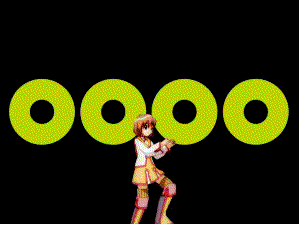
|
|
|

|
|
|
#20 |
|
~~
Join Date: Dec 2012
Posts: 711
|
__________________
 
|
|
|

|
 |
| Currently Active Users Viewing This Thread: 1 (0 members and 1 guests) | |
|
|